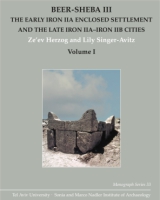
Beer-Sheba III
The Early Iron IIA Enclosed Settlement and the Late Iron IIA–Iron IIB Cities
Ze’ev Herzog and Lily Singer-Avitz
Beer-Sheba III
The Early Iron IIA Enclosed Settlement and the Late Iron IIA–Iron IIB Cities
Ze’ev Herzog and Lily Singer-Avitz
“Rigorous publication of stratigraphy and meticulous analysis of the pottery has allowed the authors to conclude that the Iron Age IIA, a period crucial for the debate on the emergence of the Biblical ‘United Monarchy,’ extends from the mid-tenth down to the early eighth century, and that the evolution of the state in Judah was initiated in the Shephelah rather than in the highlands.”
- Offers
- Description
- Reviews
Customers in Israel buy here.
During the National Parks Authority site development, there was further exposure, mainly of the water supply systems, directed by Ze’ev Herzog with David Sappo (Western Quarter, 1990–1991), with Tsvika Tsuk (the well, 1993) and finally with Ido Ginaton (the water-system, 1994–1995).
Now, after a lengthy process of analyzing the excavations in the storerooms of Tel Aviv University’s Institute of Archaeology and digging through the endless documentary material amassed, the full data is proudly presented. This work is offered not merely as a final report but as a starting point for further scientific inquiry on the abundant architectural, artifactual, and ecofactual data from Tel Beer-sheba.
Volume I reports on the stratigraphy and architecture, volume 2 on the pottery; and volume 3 on the artifacts, ecofacts, and also provides concluding studies. The three volumes are profusely illustrated and an essential resource for anyone interested in the history of Judah, the Beer-sheba Valley, the site itself, and life during the Iron Age in the southern Levant.
“Rigorous publication of stratigraphy and meticulous analysis of the pottery has allowed the authors to conclude that the Iron Age IIA, a period crucial for the debate on the emergence of the Biblical ‘United Monarchy,’ extends from the mid-tenth down to the early eighth century, and that the evolution of the state in Judah was initiated in the Shephelah rather than in the highlands.”
Mailing List
Subscribe to our mailing list and be notified about new titles, journals and catalogs.



